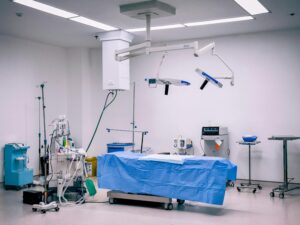It is tough to find a validation and control protocol as strict as the one used for medical device prototyping. Designing and developing the product is not simply a matter of course. Potential risks, failures, and health-compromising conditions must be identified and addressed. At RexMed, we have the experience to help you navigate this process.
Clear objectives and success criteria per build in medical device prototyping
In medical device prototyping, the bridge-building phases enable us to evaluate the product’s functionality and safety. These tests are known as EVT, DV, and PTPVT.
- EVT (engineering validation) verifies the functionality of the initial prototype.
- DVT (design validation) evaluates whether the device is reliable and manufacturable.
- PVT (production validation) is aimed at the production chain and assembly lines.
Specific metrics must be met at each stage to accomplish this:
- Functionality: The product must deliver on its promises.
- Assembly: Each part must fit perfectly.
- Performance: Is the product truly durable?
In addition, change control is essential. In other words, any engineer or specialist involved in production may request modifications to the product or its process, but a multidisciplinary committee must validate these modifications.
All of these tasks aim to ensure that the product passes through the Phase Gates. These control points guarantee that the project meets its objectives. The multidisciplinary team then approves continued development to the next phase.
Materials, biocompatibility, and sterilization compatibility
While prototyping medical devices, the team must meet strict biocompatibility standards. The device needs to fulfill its intended purpose without harming tissues or the patient. This requires selecting medical-grade materials whose safety for contact with the body has been demonstrated.
What does that mean? It means selecting materials with documented safety records. That’s why the ISO 10993 biocompatibility standard matters; it defines tests based on body contact type and duration. Those tests look for responses like cytotoxicity or sensitization.
Every medical device requires documentation, such as a Certificate of Analysis (CoA), to confirm its safety and quality. That documentation is vital for traceability so that products can be traced back to their batch.
The assessment must determine the compatibility of EtO gamma-sterilization and document the specific risks for each method. Sometimes steam is acceptable, but suitability depends on the device’s materials and its design.
Process controls and production environment
How do we ensure process and environmental control during medical device prototyping runs? To achieve that, it’s essential to understand several key points, which we will explain below.
- First, keep cleanrooms under controlled air purity per ISO 14644-1. Doing so prevents medical devices from becoming contaminated. This measure matters most for critical and sterile assemblies.
- Record short-term work instructions for brief tasks and particular requirements. They help teams respond swiftly and effectively to changing circumstances.
- A traveler or batch record must accompany the batch during manufacturing, inspection, and final release. It records every operation performed and provides the traceability needed for quality and accountability.
- A deviation is a failure to follow a standard operating procedure and requires active management. Detect, record, and act immediately to mitigate their negative consequences.
- Finally, segregating nonconforming products means setting aside devices that fail to meet the specified requirements.
These controls enable medical devices to reliably meet all required safety characteristics. Moreover, compliance is critical because numerous regulatory controls and standards explicitly require it.
Measurement and test plan
How do you verify that a device satisfies every requirement? Several independent tests are required. Dimensional metrology, for instance, confirms that measurements meet the standards used in medical-device prototyping.
Functional tests should be carried out to confirm that the device performs its intended function effectively. Several different users need to take part in those tests. The participant pool must be sufficiently large to provide statistically meaningful results.
After all tests are complete, proceed to analyze the collected data. Use Design of Experiments (DOE) to identify the process parameters that most affect outcomes. Define clear acceptance criteria and ensure they are met in testing.
Finally, validate packaging performance per ISO 11607—confirm sterile-barrier integrity, distribution robustness, and shelf-life as applicable. This includes verifying the integrity of the seal and the package, as well as conducting shelf-life studies.
Close the loop & prepare transfer
Once the validation process is complete, we should be able to capitalize on our successes and improve upon our failures. This involves updating the risk file to allow for new risk management plans. It is also essential to implement the following:
- Engineering Change Requests (ECRs) to document the need for and scope of the change
- Engineering Change Orders (ECOs), list the items to be changed.
The master data file (DMR) must be kept in line with the current medical device prototyping process and should never be forgotten. Each process must comply with installation qualification (IQ), operational qualification (OQ), and performance qualification (PQ).
These processes are all related to the pilot-bridge strategy, which guides the development process. It can identify risks, failures, and procedures to be corrected for full-scale manufacturing.
Develop your medical devices with the help of specialists.
With so many details to pay attention to, do you really have time for everything? At RexMed, we strive to be the reliable partner you can count on to comply with all production regulations.
Would you like a quote for your project? We can help. Visit our website and request information in the contact section.
FAQs
What is ISO 10993?
This standard ensures that a medical device or material will function appropriately in a specific application with an appropriate host response. The standard covers testing for toxicity, irritation, sensitization, and carcinogenic risk.
What is ISO 11607?
It is the industry standard for the sterile packaging of medical devices. The standard includes guidelines and requirements that ensure the sterility and protection of these devices from manufacturing to use.
What is the difference between an ECR and an ECO?
An ECR involves proposing changes that may be approved or rejected. An ECO is a change that has already been authorized following an ECR and must be implemented in the device documentation.






